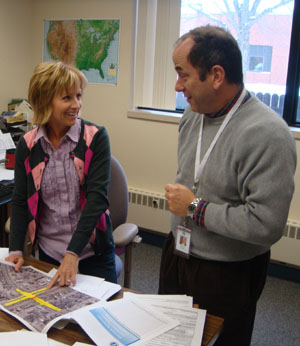By Becky Dahlberg

Rhonda Prestegard and Fausto Cabral, District 6 State Aid & Agreements, talk about an interchange project. Photo by Jessica Wiens |
Negotiation can be tough. Throw in multiple agencies, pricey improvement projects and cost-sharing, and it’s almost impossible.
Enter Rhonda Prestegard, an unassuming District 6 State Aid & Agreements employee with 27 years of Mn/DOT experience who just happens to be an experienced negotiator. Prestegard regularly collaborates with cities and counties on upcoming projects to determine who will be responsible for what.
How does the negotiation process work?
A lot of District 6 projects involve both Mn/DOT and city and county cost-sharing. I work with project managers to determine what items Mn/DOT can pay for and what items the city or county should pay for. It’s a lot of negotiation, a lot of back and forth. For example, there will be an improvement plan in place and an agency will approach us saying 'we’d like to include this in your project'—then we have to negotiate. The challenge comes from the way we look at the proposals—analyzing them for their benefit to the state highway system, as well as to the city or county road systems. Sometimes what we see as a benefit, they see as a detriment, and vice versa. Overall though, it’s a good process and we have excellent rapport with our partners. We eventually come to an agreement and have it written, signed and approved. When that’s all done the project can be let.
What’s a typical day like for you?
I wear a lot of hats. A typical day varies by the time of year. There are usually a lot of project scoping meetings with project managers to set up the boundaries of a project early on. As the project progresses, I also get involved with reviewing any plans as they come in. When the project is completed, there’s the whole review process and checking to see if there needs to be any modifications to the agreement.
How is an agreement put together?
There are many different kinds of agreements, including cost-share agreements, detour agreements and city and partnership agreements. Usually a city or county will approach us about a project and we’ll work together to write an agreement outlining the project intention. This is where all the meetings and negotiation comes in. As the project progresses, we may write a memorandum of understanding to make sure everyone is on the same page.
On the Hwy 52 Elk Run project, there are four agreements in place, with talk of a fifth on the horizon. One of those agreements advanced state money for the upcoming interchange project on the city and developer’s promise of economic development and job creation to support local growth and vitality.
Is there anything new happening in the world of agreements?
Yes. District 6 recently held a workshop introducing a new program to solicit project proposals from cities and counties called the Municipal Agreement Solicitation Program. Multiple agencies will send in their proposals, we’ll evaluate them all and then pick the ones we think will provide the most benefit to Mn/DOT and the local agency. Right now our process is more of a first-come-first-served basis. If we have funding, we’ll work with the agency to develop the project; but since there are always more requests than available funds, we’re turning it into more of a competitive process to leverage local funds to help pay for these improvements. This gives cities and counties equal opportunity to bring their proposals forward and get their issues addressed as they share ideas and establish solid partnerships.
Do you or a co-worker have an interesting job to share with readers? Click here to send us your ideas, and we’ll contact you for more information.
Recent employee profiles:
|



